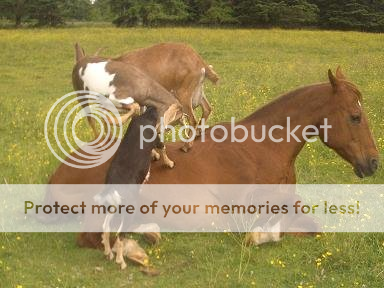No horned animals around horses, get something polled or disbudded-at-birth-if-horned. (e.t.a. well obviously you CAN keep horned animals in with horses, but it is a bit of a kick-me sign and I am bearing in mind the sorts of horses Welsummerchicks is likely to be discussing here. I've seen some horrific injuries, not necessarily intentional just two animals moving the wrong way at the wrong time and now there is a face to suture up)
Two sheep are not real happy IME (I got my first two several weeks before the other three, and there was a very noticeable change in their behavior, like 'ah, finally we have sort of a flock') -- not to say it can't be done, but they seem to be happier as five or more.
The big thing is that sheep require different type fencing than horses, this has been a very "learn as you go" lesson for me
The two things sheep do that are a total non-issue with horses are they will headbutt the fence at sheep noggin level to see if they can make the fence go away by that means; and they will wedge themselves thru the fencing from underneath (even if it is woven wire all the way to the ground, they will WORK on that bottom edge til they can create enough slack to get through). Also they are BIG predator magnets, unlike horses. (Peoples' pet dogs included in the "predator" category).
Just running a few extra strands of electric is a riskier way to go from a sheep perspective, unless you are ok with them getting out sometimes and are willing to play predator roulette (although if you can lock them into an extremely secure night yard, that will help against 'natural' predators, tho not against loose dogs). Woven wire (like 4x4 small-stock mesh) is a lot better, and if there are places you expect they will test the fence, or if you SEE them testing the fence, add a row of boards just above the ground or a standoff electric wire at headbutting height.
However using woven wire is of course a little riskier from the *horse* perspective, as a horse wheeling or slipping while running against the fenceline can put a foot catastrophically thru the mesh, as you know.
IMO the ideal situation is 2x4 welded wire mesh along the bottom of the fence (with the aforementioned boards or wire-or-electric-twine added if there is any suggestion of sheep trying to break out). This is not the cheapest thing but is the safest for both species.
I've done most of my front paddock and driveway paddock in 2x4 wire (added to the existing 4-board wooden fencing, I mean) so that it can be dual use; but the wet paddock, which is only for occasional sheep use, I've just got the small-stock fencing on the board fence.
Another option that you might seriously consider is electronet. I would not use it where *goofy* horses were on the other side of it, because a horse skidding into it and getting tangled up would be A Bad Thing; but if you can close the paddock off, then a length or two or three of electronet can be used to run the sheep safely in there without having to make any structural changes to the "real" fencing. You do need to get the grass scalped way down to the ground along the fenceline and keep it that way, and when the mfr's say you "may" need extra posts nad tiebacks "in windy locations", my experience is that they mean "you had BETTER use extra posts and tiebacks, period"
but that is quite easy to do.
Actually I think if I had a better fence charger <g> and had it to do over again, I would probably go with the electronet-within-normal-horse-fencing option, rather than trying to sheepproof any of the horse fencing. Or maybe only sheepproof enough for their winter needs (electronet is useless in snow).
I can't give any direct advice on whether to allow them together. It depends. My ram escaped into the horse paddock a couple times (see above re: learning curve about sheep =/= horses w/r/t fencing) and they made him *miserable*, running him all around, even my exceedingly creaky and sorefooted senior TB was playing cutting-horse with the poor guy; and I know people in Britain with various amusing stories about horses that enjoy picking smaller sheep up with their teeth (in the wool) and carrying them around. OTOH I know there are a bunch of people who *do* have horses and sheep pastured together so obviously it can be done.
Have to keep sheep from getting into horse feed or horse mineral blocks, sheep are highly intolerant of levels of copper that are normally supplied to all other livestock.
(edited because I forgot to say: I have been quite pleased with the job the sheep do on cleaning up the roughs and weeds left by the horses. They are not *as* good as mowing, but a lot less work, especially for non tractor owning non riding-mower owning people like me
I assume they do some good with parasite load too, but to me that's an incidental. Actually I *got* them for milk for cheesemaking, not *for* rotational grazing, but have been surprised and pleased how useful they are for the latter.)
(edited again to add: if you are non-vegetarian you might also consider that instead of a pair of ewes you could get a handful of 'feeder sheep' in the spring, let them manage your pastures for you til the grass goes away in teh fall, and then send them off to freezer camp. This way they do something useful for you in addition to lawnmowing, parasite load is not quite *as* much of an issue, and you don't have to feed and house them all winter, you just start over the next year with a new batch)
Pat






